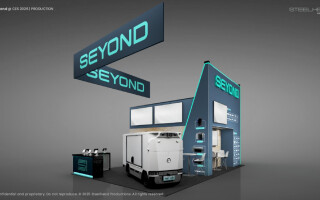COM Express Rev. 2.0 welds new chip functionality to embedded needs
May 01, 2011
Do your homework! PICMG’s latest COM Express pin-out specifications yield increased ability, but only with a healthy understanding of Revision 2...
New functionalities that Intel, AMD, and other processor manufacturers have integrated into their latest processor families have sparked specification revisions to leverage the new IC architecture capabilities. The individuals responsible for revising COM Express also recognized the importance of making space for possible future technologies. Supporting advanced graphics and displays has ever-increasing significance for embedded computing platforms. And the dynamics of the design process must also take into account embedded industry trends for miniaturization and mobility, which continue to challenge board and module suppliers to develop and standardize the smallest factors possible.
PICMG recently released Revision 2.0 of the COM Express Computer-On-Module standard to address next-generation embedded system requirements that have come about due to the additional graphics and display capabilities that the latest processor architectures afford. But taking advantage of this enhanced functionality and applying it to small form factor development requires that designers have a thorough understanding of the Revision 2.0 pin-out Type definitions and the important considerations for implementing them.
Pin-out Types 1 to 5: Going from legacy to legacy-free
The goal of the PICMG organization’s vendor-independent interface specifications and form factors is to give designers a solid platform on which to develop products that are future-oriented and promise long-term availability.
Pin-out Type 1 starts with a single connector and support for legacy host and communication interfaces. Type 2 builds on the functionality by adding a second connector, and Type 2 upgrades support for a 32-bit PCI interface plus IDE ports to support legacy PATA devices and CompactFlash memory cards. There also are more PCI Express lanes available that support PCI Express Graphics (PEG). Comparing pin-out Type 3 to Type 2 reveals that on pin-out Type 3 only the IDE pins are replaced, making way for extra Gigabit Ethernet (GbE) capability. Consequently, Type 3 has no legacy interfaces, but now supports up to three GbE channels. In pin-out Type 4, pins reserved for PCI are reallocated, creating space for 10 additional PCI Express lanes. These can be used as PCIe lanes 0-15 or as second PEG port lanes 16-31. Finally, pin-out Type 5 combines the changes from Types 3 and 4.
Pin-out Type 6 takes graphics to another level
PICMG developed the Type 6 pin-out of the COM Express standard specifically to utilize the expanded graphics capabilities of new processor families. With Type 6, legacy PCI pins are now used to support the digital display interface and for additional PCI Express lanes. Furthermore, pins previously assigned to the IDE interface are now reserved for future technologies still in development. One of these possible future technologies could be SuperSpeed USB, because the 16 free pins offer sufficient lines to implement USB 2.0 ports as SuperSpeed USB (USB 3.0) ports, which require an extra pair as compared to USB 2.0.
Intel selected the COM Express support of PEG as a high-speed bus for external graphics cards. These cards satisfy the growing need for performance and also support different output devices. The Type 6 pin-out has been specifically defined to scale for these requirements.
Pin-out Type 6 supports advanced graphics options by offering three new ports dedicated to new Digital Display Interfaces (DDI). Embedded system designs can configure these ports individually for High-Definition Multimedia Interface (HDMI) or respectively with the electrically compatible Digital Visual Interface (DVI) or DisplayPort (DP). DDI port 1 supports additional Serial Digital Video Output (SVDO). SDVO is not multiplexed on the PEG port in Type 6 (such multiplexing has been possible under the pin-out Type 2 definition). However, with Type 6, an external PEG graphics card can be used in parallel with embedded graphics, for example, for multimonitor applications with more than four screens or for data processing using general-purpose Graphics Processing Units (GPUs).
Support for SDVO is now officially part of the COM Express standard in Rev. 2.0. With the SDVO interface supported by Intel chipsets, COM Express has the flexibility to support a wide variety of graphics signals. For example, designers can now easily implement DVI. DVI enables designers to cost-effectively integrate digital monitors and dual-display solutions.
Type 6 allows developers to utilize DisplayPort, HDMI, and DVI graphical interfaces through DDI. DisplayPort is a universal interconnect, and unlike HDMI, is royalty-free standardized by VESA, ensuring its widespread popularity. DisplayPort not only has a much higher data transfer rate of 17.28 Gbps (compared to 2.835 Gbps with LVDS and 4.95 Gbps with DVI), but also a micro-packet protocol, allowing simple expansion of the standard. DisplayPort also supports an auxiliary channel. This allows a bidirectional connect to control devices by VESA standards such as E-DDC, E-EDID, DDC/CI, and MCCS to provide genuine plug-and-play operation. Adding to DisplayPort flexibility, its auxiliary channel can be used for peripherals such as touch-panel displays, USB connects, cameras, and microphones.
DisplayPort could eventually replace HDMI (the current consumer market’s favorite interface). HDMI was not developed for the embedded market, and the experience in the field is that HDMI is subject to frequent driver and mechanical changes. DisplayPort better matches embedded application needs that include long-term availability of up to seven years.
Going even smaller with Type 10
Type 10 addresses the requirements of newer and extremely small processors. There are differences to watch out for when migrating from Type 1 to Type 10 even though both pin-out types are compatible with each other. In pin-out Type 1, SATA ports 2 and 3 are assigned pins in rows A and B, but these are no longer reserved in pin-out Type 10. The pins could still be used as SATA ports, but are now reserved for alternative purposes such as USB 3.0. When migrating from Type 1 to Type 10, it is recommended not to wire SATA 2 and 3 over the module connector, so the modules remain compatible and are ready for USB 3.0 at the same time. Table 1 indicates the differences.
With the arrival of COM Express Rev 2.0, Type 10 and Type 6 support serial ports. The pins were formerly used for VCC 12 V. However, dedicated manufacturers such as Kontron ensure compatibility with existing carrier boards by including a protective circuit on the module. Developers can use the new capabilities while avoiding the time and expense of completely modifying existing carrier board layouts.
A further difference is that Type 10 uses the second LVDS channel, TV out, and VGA to support the SDVO port (or alternatively DisplayPort or HDMI/DVI) via DDI. Despite being eliminated from Type 10, VGA support will not be missed, as it is expected to play only a minor role in future. Type 10 modules (such as the Kontron nanoETXexpress-TT) provide native support not only for latest display interfaces, but also for dual independent displays, as they will continue to support an LVDS channel. Customers who have been using ultra-small modules such as the Kontron nanoETXexpress-SP may not find the differences of much consequence. Atom-based Type 1 modules were designed such that the modules have reserved pins from the former VGA and second channel LVDS pins for SDVO support.
Type 10 and Type 6 now also support Secure Digital I/O (SDIO), multiplexed on the existing GPIO signals. Optionally, two 3.3 V TTL serial ports are added, which many legacy applications require. These changes demonstrate the flexibility of the PICMG standard in responding to the needs of the market. Both ports can be used for different purposes such as RS-232, RS-485, a CANbus, or other two-wire interfaces.
Universal changes
Further changes that affect all of the COM Express module types are that the connector in the present form is now approved for PCI Express (PCIe) Gen2 signals. While no physical change to the connector or its pins has taken place, developers must adhere to new rules for PCIe Gen2 when routing the module and carrier board. Additionally, the AC’97 pins are now used to support AC’97 and HD audio.
Another change that affects all pin-outs is that in addition to the previous firmware hub, there is a new BIOS firmware interface for internal and external boot that has been implemented by next-generation processors. This is a Serial Peripheral Interface (SPI), the future interface for firmware flash on the module and carrier board. The specification reserves pins to use for SPI. COM Express Rev. 2.0 specifies external firmware support for all module types. The Low Pin Count (LPC) interface served this purpose in the earlier version, and new modules must support SPI but may still additionally support flash firmware externally through LPC if the chipset continues to support it. The reason for this change in firmware flash is that new small form factor processors only support SPI boot devices.
Advantages arrive as smaller “compact” form factor debuts
The COM Express Rev. 2.0 defines the dimensions of a new compact form factor module as 95 mm x 95 mm, and aside from the reduced footprint, the physical requirements, connector placement, and pin-out are exactly the same as those of the successful basic form factor. The benefit is that widely adopted pin-out Type 2 designs can now also be used in space-constrained applications (Figure 1).
Summary
The updated specification for COM Express modules is a much-needed response for matching new processor architecture functionality and the needs of the market. A standard can only be sustainable if it adapts flexibly to new demands such as miniaturization and graphics performance. The PICMG COM Express Rev. 2.0 standard gives embedded designers a good indicator of what the future holds. As the only vendor-independent standard for Computers-On-Modules, COM Express continues to be an important enabler of future advanced applications for the embedded market. Demonstrated by the new compact form factor and two new pin-outs defined by Rev 2.0, the strengths of the COM Express concept have been preserved in their entirety. They offer embedded system designers full compatibility for existing applications, along with proven standards that have been adapted to the new requirements and new features.
Kontron [email protected] www.kontron.com







